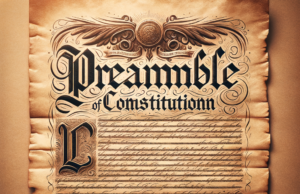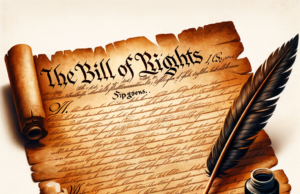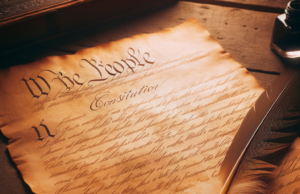Table of Contents
- 1
- 2
- 3
- 4
- 5
- 6
- 7
- 8
- 9
- 10
- 11
- 12
- 13
- 14
- 15
- 16
- 17
- 18
- 19
- 20
- 21
- 22
- 23 Advantages and Disadvantages of Amendments
- 24
- 25
- 26
- 27
- 28
- 29
- 30
- 31
- 32
- 33
- 34
- 35
- 36
- 37
- 38
- 39
- 40
- 41
- 42
- 43
- 44
- 45
- 46
- 47
- 48
- 49
- 50 What are the Constitutional Amendments?
- 51 The History of Constitutional Amendments
- 52 Approving Constitutional Amendments
- 53 Step 1: Passing a Constitutional Amendment
- 54 Step 2: Passing a Constitutional Amendment

Constitutional amendments are changes made to the fundamental laws of a country that modify the basic rules and principles on which the nation operates. These changes are only considered by governments and citizens when it is clear that the existing laws are not adequate. This article will explore the different types of constitutional amendments, the process of amending a constitution, the reasons for making amendments, the advantages and disadvantages of amendments, and some notable amendments in history.
Types of Constitutional Amendments
There are two main types of constitutional amendments: formal and informal amendments.
Formal Amendments
A formal amendment is a written revision to the Constitution that follows a specific procedure outlined in the original document. In the United States, for example, the process of amending the Constitution is outlined in Article V, which states that two-thirds of both the House of Representatives and Senate must approve the proposed amendment before it is presented to the states for ratification. Three-fourths of the states must then approve the amendment for it to become law.
In other countries, like Australia, the process of amending the Constitution is different. Here, the Constitution can only be amended if a referendum is passed by the majority of voters in a majority of states. However, the specifics of this process can vary depending on the country in question.
Informal Amendments
An informal amendment refers to changes that are made to the Constitution without going through the formal amending process. In the United States, for example, the Supreme Court has the power to interpret the Constitution. Through this interpretation, the court has established a number of legal doctrines that go beyond the words of the Constitution. One example of this is the establishment of the right to privacy, which was not explicitly included in the original text of the Constitution.
Other examples of informal amendments include changes to the fundamental rules of government through practices, customs, or traditions that are not necessarily written in the Constitution. These changes are often the result of evolving societal norms or changes in political landscapes. For example, the Twenty-Second Amendment, which limits the number of terms a President can serve in the United States, was passed in response to Franklin D. Roosevelt’s four-term presidency.
The Process of Amending a Constitution
The process of amending a Constitution can vary depending on the country in question. However, there are some common steps that are generally followed.
Proposal
The first step in amending a Constitution is to propose an amendment. This can be done by the government, the legislature, or a citizen’s initiative. In the United States, for example, a proposal must be approved by two-thirds of both the House of Representatives and Senate before it can be sent to the states for ratification.
Ratification
The next step is ratification, where the proposed amendment must be approved by a certain number of states or other government organizations. In the United States, for example, three-fourths of the states must approve the amendment for it to become law.
Promulgation
Once a proposed amendment has been ratified, it must be promulgated or formally communicated to the public. This is usually done through the publication of the amendment in the official government gazette or through a formal ceremony.
Enactment
The final step is enactment, where the amendment becomes an official part of the Constitution. This can happen immediately after promulgation, or it can be delayed until a future date, depending on the specific amendment.
Reasons for Making Amendments
There are many reasons why a government might choose to make amendments to their Constitution. One common reason is to address issues or concerns that were not addressed in the original text. For example, in the United States, the Thirteenth Amendment was passed to abolish slavery, as this issue was not addressed in the original Constitution.
Another reason for making amendments is to adapt to changing circumstances or societal norms. The Twenty-Sixth Amendment, for example, lowered the voting age from 21 to 18 in response to the changing role of young people in society.
Advantages and Disadvantages of Amendments
Advantages
One of the main advantages of making amendments to a Constitution is that it allows for flexibility and adaptation. As society changes over time, it is important for the rules and principles that govern it to also evolve. By allowing for amendments, a Constitution can remain relevant and effective, even as circumstances change.
Another advantage of amendments is that they can help to clarify or strengthen the existing text of a Constitution. In some cases, the original text of a Constitution may be vague or open to interpretation. Amendments can help to clarify these issues and provide a more precise framework for governance.
Disadvantages
One potential disadvantage of making amendments to a Constitution is that it can be a slow and cumbersome process. In some cases, it may take years or even decades to pass a proposed amendment, which can slow down important changes needed for the betterment of society.
Another disadvantage of amendments is that they can be divisive and contentious. As seen in the United States, proposed amendments can spark heated debates and disagreements, which can lead to fractured societies and political gridlock.
Notable Constitutional Amendments
Throughout history, there have been many notable constitutional amendments that have shaped the course of nations. Some of the most significant amendments include:
The United States Constitution
The United States Constitution has been amended 27 times since it was first ratified in 1788. Some notable amendments include:
The First Amendment, which guarantees freedom of religion, speech, and the press.
The Fifteenth Amendment, which prohibits denying the right to vote based on race, color, or previous servitude.
The Eighteenth Amendment, which prohibited the production, sale, and transportation of alcoholic beverages (later repealed by the Twenty-First Amendment).
The Nineteenth Amendment, which gave women the right to vote.
The Twenty-Sixth Amendment, which lowered the voting age to 18.
The Australian Constitution
The Australian Constitution has been amended only eight times since it was first ratified in 1901. Some notable amendments include:
The Australian Capital Territory (Self-Government) Act 1988, which granted self-government to the Australian Capital Territory.
The Constitution Alteration (Senate Elections) Act 1906, which established a uniform system for electing members of the Senate.
The Constitution Alteration (Aboriginals) Act 1967, which removed discriminatory references to Aboriginal people in the Constitution.
The Canadian Constitution
The Canadian Constitution has been amended several times since it was first ratified in 1867. Some notable amendments include:
The Constitution Act, 1982, which repatriated the Constitution from British control and added the Canadian Charter of Rights and Freedoms.
The Constitution Act, 1867 (originally known as the British North America Act, 1867), which established the framework for Canadian confederation.
Conclusion
In conclusion, constitutional amendments are an important part of democracy, allowing governments and citizens to modify the basic rules and principles on which their nation operates. While the process of amending a Constitution can be slow and cumbersome, it is an essential tool for adapting to changing circumstances and ensuring that society continues to thrive. As such, it is important that we continue to recognize the importance of constitutional amendments and work to ensure that our laws remain relevant and effective for generations to come.
What are the Constitutional Amendments?
Although the Constitution of the United States is considered to be the foremost piece of the legislature with regard to the implementation and authorization of legality and lawfulness within the United States; upon its creation, the Constitution of the United States not only outlined a framework for a legislative system, but also an identifiable statute with regard to alterations, adjustments, and modifications to the original text:
The Founding Fathers had instated a procedure for the adjoining of subsequent Constitutional Amendments in order to bestow in it a quality allowing it to avoid irrelevance
The Founding Fathers had understood that as the United States underwent progression, innovation, and an invariable paradigm shift, certain legal statues would require modification
In order to retain the innate framework of the Constitution of the United States while allowing for measures of adjustment and modernization, a policy was implemented with regard to the adoption of future – and potential – Constitutional Amendments
The History of Constitutional Amendments
While James Madison is credited as one of the primary authors of the Constitution, he is primarily credited with the conception of the Bill of Rights. This appointment is due to his concern with regard to an absence of a Constitutional Clause providing the document with a procedural system allowing for both the amendment and adjustment of the original text:
Subsequent to the voicing of his concerns, a Constitutional Clause was created that rectified the prospective alteration process, which made way for the inclusion of Constitutional Amendments
James Madison’s foresight resulted in the proposal of the Bill of Rights in 1789, in addition to its subsequent ratification in 1791; the Bill of Rights is the moniker given to the first 10 Constitutional Amendments passed – they were all passed at the same time
Approving Constitutional Amendments
In order to successfully pass Constitutional Amendments, a process exists that requires a variety of levels of approval and acknowledgment from a variety of legislative bodies:
Step 1: Passing a Constitutional Amendment
Congress must approve of the proposed Constitutional Amendments through a vote illustrating a 2/3rd’s majority – this applies for both the House of Representatives, as well as the Senate
Individual state legislation will be required to convene; only after a 2/3rd’s majority vote will the Constitutional Amendments proposed move to the next step of the approval process
Step 2: Passing a Constitutional Amendment
Subsequent to the completion of the first step, the ratification – or adoption – the process will be required to take place; this approval process may take place in ONE of the following TWO methods:
Method #1: Within each of the individual states participatory in the approval of the proposed Constitutional Amendments, a 3/4th’s majority vote of approval must result
OR
Method #2: With regard to the individual states participatory within the previous approval process, each state must conduct a convention during which time that state’s Constitution is amended in order to reflect the adoption of the proposed Constitutional Amendments – this majority approval must occur as a 3/4th’s majority


























